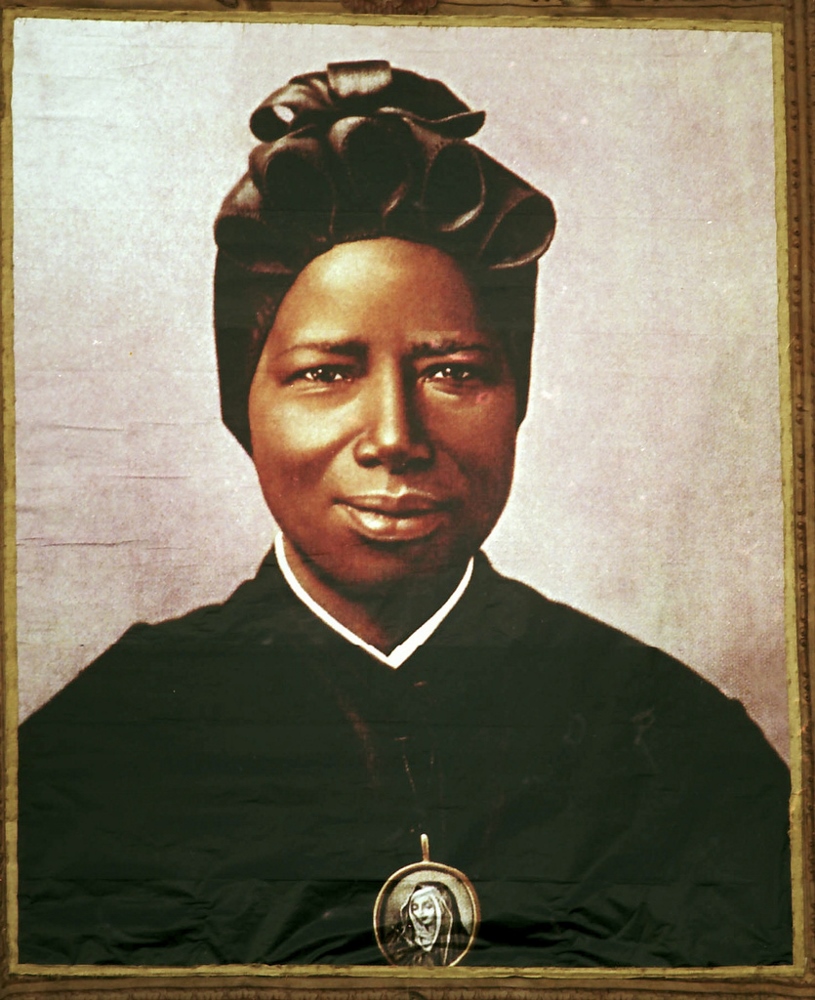Saint Josephine Bakhita
If I were to meet those who kidnapped me, and even those who tortured me, I would kneel and kiss their hands. For, if these things had not happened, I would not have been a Christian and a religious today.

A tapestry portrait of St. Josephine Bakhita, hung at the facade of St. Peter's Basilica during her canonization in 2000 at the Vatican.
These were the words of Saint Josephine Bakhita, a Canossian Sister who was kidnapped as a young girl in her home country, Sudan and sold into slavery.
In her early years, Josephine Bakhita belonged to the Daju people and was a daughter of the village chief’s brother. She had six siblings – three brothers and three sisters and was part of a loving family.
Sometime between the age of seven to nine, probably in February 1877, she was kidnapped by Arab slave traders, who had already kidnapped her elder sister two years earlier. She was resold several times and during this time Josephine Bakhita was beaten (even to the extent that she couldn’t walk), abused, and salt-scarred. The trauma of her abduction caused her to forget her own name and Mocking her, her captors named her “Bakhita,” which means “fortunate”.
in 1883, Saint Josephine came into the service of an Italian family who ended up bringing her to Europe. Two years later, the family gave her to their friend Augusto Michieli. Bakhita became babysitter to Mimmina Michieli, whom she accompanied to Venice’s Institute of the Catechumens, run by the Canossian Sisters. While Mimmina was being instructed, Josephine felt drawn to the Catholic Church.
When she encountered Jesus, depicted on a cross, she resonated with the image because she too knew the pain of beatings and abuse. When she was given her own crucifix, one of the first possessions she could call her own, she felt something beyond her understanding. She joined the catechumenate and was baptized and confirmed in 1890, taking the name Josephine Margaret Mary Bakhita.
When the Michielis returned from Africa and wanted to take Mimmina and Josephine back with them, the future saint refused to go.
During the ensuing court case, the Canossian Sisters and the patriarch of Venice intervened on Josephine’s behalf. The judge concluded that since slavery was illegal in Italy, she had actually been free since 1885. Josephine remained in Italy and decided to enter Canossians in 1893. She made her profession in 1896 and was sent to Northern Italy, where she dedicated her life to assisting her community and teaching others to love God.
A young student once asked Josephine Bakhita: “What would you do, if you were to meet your captors?” Without hesitation she responded: “If I were to meet those who kidnapped me, and even those who tortured me, I would kneel and kiss their hands. For, if these things had not happened, I would not have been a Christian and a religious today.”
Her last years were marked by pain and sickness. She used a wheelchair, but she retained her cheerfulness. Josephine died on February 8, 1947. For three days, her body lay on display while thousands of people arrived to pay their respects. But death marked the beginning of her next journey to sainthood which only began after 12 years.
On December 1, 1978, Pope John Paul II declared her Venerable. She was declared Blessed on May 17, 1992 and given her February 8 Feast Day. Finally, on October 1, 2000, she was canonized and became Saint Josephine Bakhita.
Today, Saint Josephine Bakhita is the Patron Saint of Human Trafficking. She is a shining ray of hope for victims of human trafficking and an inspirational demonstration of how a victim can recover from their trauma and become whole again.
Her story also invites us to take an honest look at our own connections to the social sin of human trafficking. What actions might we take to curb this menace?
Other resources: